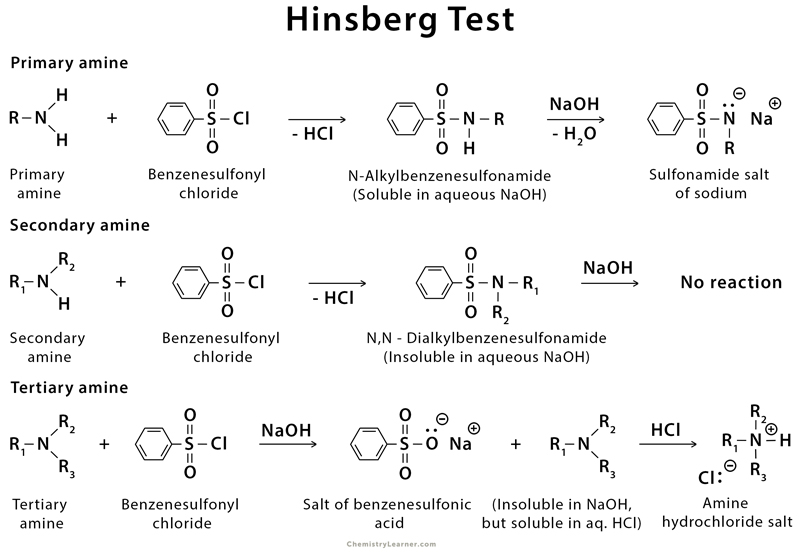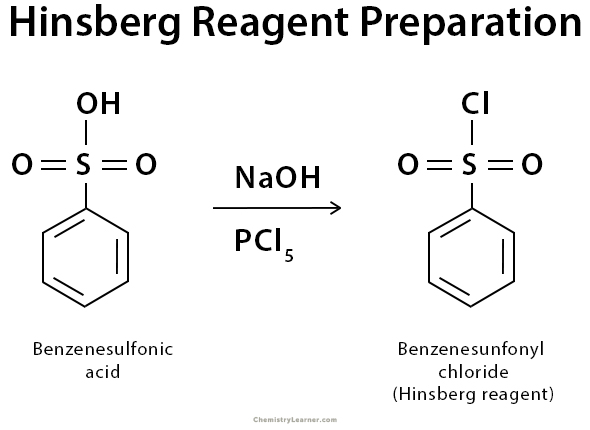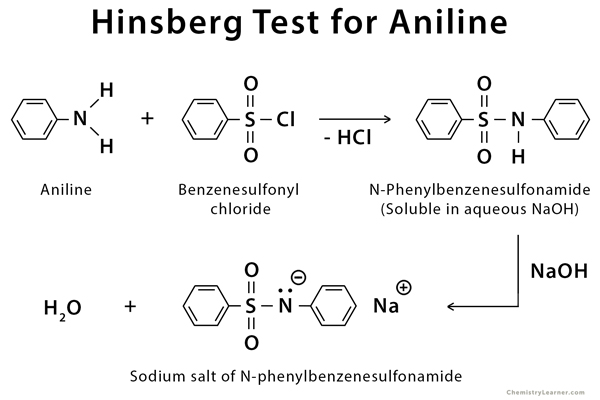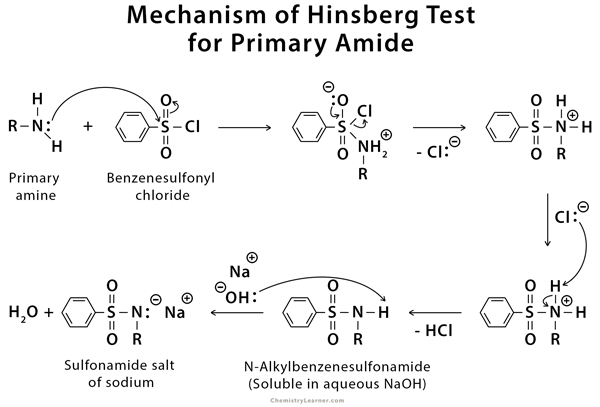Hinsberg Test
Definition: What is Hinsberg Test?
Hinsberg test is a chemical reaction that can distinguish between primary, secondary, tertiary amines. The amine is shaken well with Hinsberg reagent in the presence of aqueous alkali (e.g., KOH or NaOH). The Hinsberg reagent is a solution of aqueous sodium hydroxide and benzenesulfonyl chloride. In this test, the amine acts as a nucleophile and attack the electrophilic benzenesulfonyl chloride. This reaction leads to the displacement of the chloride and the generation of the N- alkylbenzenesulfonamide. When the primary amine forms a sulfonamide, this product is soluble in aqueous sodium hydroxide (NaOH). On the contrary, secondary amine’s sulfonamide precipitates from the alkali solution as a solid [1-3].
The history of this reaction goes back to 1890 when the reaction was described first by the German chemist Oscar Heinrich Daniel Hinsberg.
Preparation of Hinsberg Reagent
The chlorination of benzenesulfonic acid with phosphorus pentachloride (PCl5) in sodium hydroxide (NaOH) gives Hinsberg reagent.
Principle of Hinsberg Test
The Hinsberg test is based upon sulfonamide formation. In the Hinsberg test, an amine reacts with benzenesulfonyl chloride. If a product forms, the amine is either a primary or secondary amine, because tertiary amines do not form stable sulfonamides. If the sulfonamide that forms dissolves in aqueous sodium hydroxide solution, it is a primary amine. If the sulfonamide is insoluble in aqueous sodium hydroxide and hydrogen chloride, it is a secondary amine. The sulfonamide of a primary amine is soluble in an aqueous base because it possesses an acidic hydrogen atom on the nitrogen. This hydrogen atom loses to the base sodium hydroxide resulting in a sulfonamide sodium salt. Tertiary amine does not react with the benzenesulfonyl chloride. It, initially, provides an insoluble solid or oil (unreacted amine), which, on acidification with hydrogen chloride, dissolves to give a clear solution of the amine salt [1-5].
Procedure for Hinsberg Test [4,5]
- Add 8-10 drops of amine to a large test tube
- Add 10 drops benzene sulfonyl chloride
- Add 10 mL 10% NaOH
- Shake vigorously to mix (use a cork)
- Check for the presence of a single layer (primary amine) or a double layer (secondary amine) in the solution
- In there is a double layer, draw off the lower aqueous layer with a separatory funnel and check if the organic layer is soluble in 5% HCl (If it is not soluble, then secondary amine is present)
Hinsberg Test for Aniline
A typical example of the Hinsberg test is the reaction of benzenesulfonyl chloride with aniline, a primary aromatic amine.
Mechanism of Hinsberg Test
The amine first reacts with benzenesulfonyl chloride in an addition-elimination reaction on the highly electrophilic sulfonyl chloride derivative. After the stepwise loss of the chlorine and one proton from the amine in the presence of sodium hydroxide, the resulting product is a sulfonamide salt of sodium.
References
- Definition and reaction – Onlinelibrary.wiley.com
- Definition and reaction – Chem.libretexts.org
- Definition and reaction – Chemistry.msu.edu
- Procedure – Myweb.liu.edu
- Procedure – Jove.com








